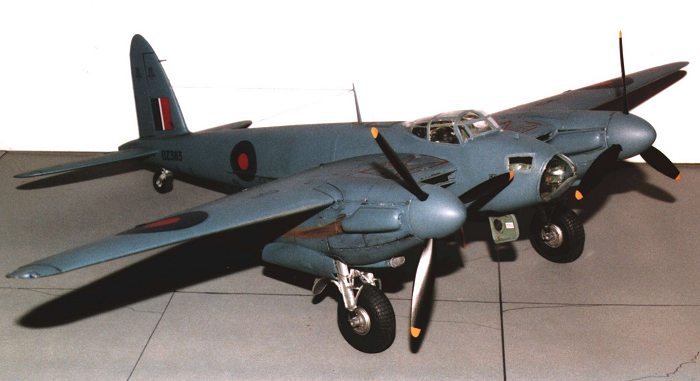
|
KIT: |
Tamiya 1/48 Mosquito B.IV/PR.IV |
|
KIT # |
61066 |
|
PRICE: |
AUD $50.00 |
|
DECALS: |
3 Aircraft 105, 109 and 540 Squadrons |
|
REVIEW & |
Grenville Davies |
|
NOTES: |
If it looks like and sounds like a Mossie, "Achtung! Moskito!" This is a fantastic kit that, if thrown into the air unassembled it would land as a completed kit! |

|
HISTORY |
The Mosquito is probably one of the most well known of all the Allied Aircraft that flew during World War II. It became known as the "Wooden Wonder" and has been the subject of two films about daring raids performed during the conflict. It began as a dream by the De Havilland Company although it almost didn’t get off the drawing boards. The Air Ministry was reluctant to adopt the "wooden" aircraft and initially placed an order for 50 aircraft in March 1940 to be used in the reconnaissance role. The limited nature of the prototype production resulted in it being removed from official planning three times after the Dunkirk evacuation. Each time it was daringly put back by a single believer, Patrick Hennessy (later Sir Patrick), who had been brought in from Ford Motors to help run British aircraft production.
The Mossie began it’s life in 1939 as the brainchild of the De Havilland Company, who envisioned a plane that would be an unarmed high-speed bomber, using their experience with the Comet, a wooden racer. Using wood for the majority of the construction, with the exception of the engines and landing gear, certain strategic advantages were to be had. Initially the work was carried out on a military derivative of the aerodynamically superb, but technically disastrous DH. 91 Albatross airliner, with a structure made entirely out of wood. A few months later work began on a military derivative with twin Merlin engines designed to meet the requirements of Specification P.13/36. This was not accepted, largely due to the wooden structure not being taken seriously. The project staff under R.E. Bishop, R.M. Clarkson and C.T. Wilkins, were undeterred and continued to study a high-speed bomber with the ability to evade hostile fighters and thus dispense with gun turrets. (World Military Aircraft – File 079 de Havilland DH.98 Mosquito)
This concept of removing the need for gun turrets also had the advantage of reducing the crew from six to two, comprising the pilot on the left and the navigator/bombardier on his right, with either crewmember able to operate the radio. The result of this equation was a weight saving that enabled the aircraft to be smaller and would thus burn less fuel. It was also calculated that the aircraft would be capable of carrying 1000lb of bombs 1,500 miles for a weight of just over 15,000 lb (6800kg). With careful streamlining the aircraft would be capable of speeds up to 400mph (655km/hr), almost double that of current bombers and as fast as the fastest fighters then available to the enemy. The bomb load was eventually increased with the aircraft being converted to carry a 4,000lb "cookie"!
During initial trials conducted in November 1940, the aircraft attained speeds of 630 km/hr, demonstrating it’s potential. The Air Ministry quickly placed an additional order for 150 aircraft.
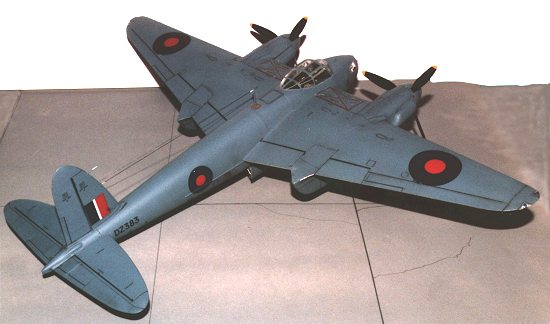 The first squadron to
receive the B Mk.IV series II was No. 105 Squadron of No.2 Group, based at
Swanton Morley in November 1941. The next unit to receive this phenomenal
aircraft was No. 139 Squadron based at Marham. A single aircraft – W4072, flew
the first mission after the "1,000-bomber" raid on Cologne on 30-31
May 1942. Following various ineffective sorties the aircraft began to gain
successes using low-level, high-speed, precision bombing attacks throughout
Europe. It was the beginning of a legend.
The first squadron to
receive the B Mk.IV series II was No. 105 Squadron of No.2 Group, based at
Swanton Morley in November 1941. The next unit to receive this phenomenal
aircraft was No. 139 Squadron based at Marham. A single aircraft – W4072, flew
the first mission after the "1,000-bomber" raid on Cologne on 30-31
May 1942. Following various ineffective sorties the aircraft began to gain
successes using low-level, high-speed, precision bombing attacks throughout
Europe. It was the beginning of a legend.
The photo-reconnaissance roles proved to be highly effective and the Mosquito was used as a pre and post bombing observation platform. The PR Mk. IV was the camera variant of the B Mk. IV. Other variants were subsequently built, such as the FB Mk.IV, fighter-bomber, armed with four under nose Hispano 20-mm cannon and four nose-mounted 0.303in Browning machine-guns (other armament was used throughout the Mosquito’s service life). The FB Mk.IV was the most prolific of the variants, with 2,584 built. The Luftwaffe pilots held this aircraft in such awe that it led some bomber variants to be painted in the same camouflage as the fighter-bomber in an attempt to make enemy pilots wary of them. This was not terribly successful and pilots usually found their superior speed to be their best defence, putting it on the deck, throttles to the bump stops and head for home. The PR Mk.IV discovered the German Battleship Tirpitz that ultimately led to her capsizing after a bombing raid. They were also instrumental in scouting V2 rocket sites
Few Luftwaffe aircraft were capable of running down these greyhounds of the sky; amongst them were the Fw 190’s and the Me262 jet fighter, the former being 5mph faster. The Me262 was in a class all by itself and, fortunately for the Mosquito pilots, came onto production too late in the war to be effective against "Achtung! Moskito!"
|
THE KIT / CONSTRUCTION |
What does one say about Tamiya? Sigh! The kit goes together sooo well. The level of detail is superb and is everything to which modern kit manufactures should aspire. There is certainly enough detail to keep most modelers salivating …however there is always room for improvement if one so desires! I did so desire and this resulted in some rather obsessive behavior on my part – my wife simply nods her head at my final acknowledgement of her many times uttered statement. The obligatory gripe is that Mr. Tamiya insists on putting his colours only in the instructions, without due thought to those of us who prefer other brands – very tyrannical of them really. They are not the only company that practises this black art, but one would like to think that with the plethora of paint manufacturers around that some of the kit manufacturers would recognize companies other than their own? I remain optimistic and keep my trusty paint conversion chart handy at all times!
The kit is presented on seven sprues, six grey and one clear. In addition the kit supplies two polycaps for the propeller and a decal sheet for three variants. The instruction sheet begins at the engine nacelles and continues through the wing assemblies and bomb bay construction. It is necessary to have decided which variant is to be built as each has specific construction, clearly defined throughout the instruction sheet.
The nose cone is separate and requires some very detailed painting, again clearly shown in the instruction sheet. But, this was not enough for me and I decided to upgrade the kit with Cutting Edge Mosquito B.IV/PR.IV Cockpit Super Detailing Set (CEC48139). This made the inclusion of the cockpit plumbing unnecessary and included some detail that has been omitted by Tamiya. Oh well, that’s what after-market companies are for, right?
The Cockpit
As I said earlier, I had elected to use the excellent after-market Cockpit Super Detailing Set of Cutting Edge, kit no. CEC48139. This is highly detailed resin and gives explicit instructions to cut the original fuselage to locate the resin cockpit walls. The kits includes both fuselage quarters, front and back instrument panel complete with instrument panel acetate (mine somehow managed to go to that hole in the floor where all dropped parts disappear), radio instruments, pilot and navigator seats as well as the rudder pedal enclosure and throttle assembly.
All parts were sprayed with enamel Model Masters, RAF Interior Green and then the relevant parts and subassemblies were painted according to my references. The myriad wires were generally painted a light grey, the flares were painted an off-white and individual colour bands applied to differentiate their purpose. The references had a variety of colours displayed for the seat covers and I settled for brown.
The cockpit halves were dry fitted constantly to ensure that nothing would stop the mating of the fuselage. It was to be prophetic when it came time to attach the canopy, alas too late to correct the problem.
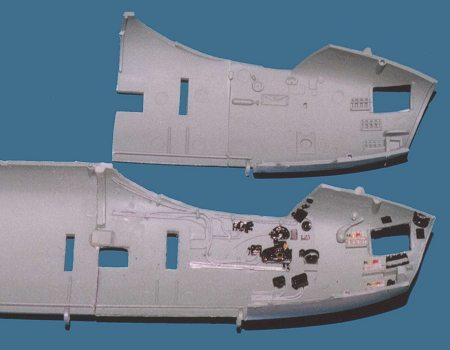 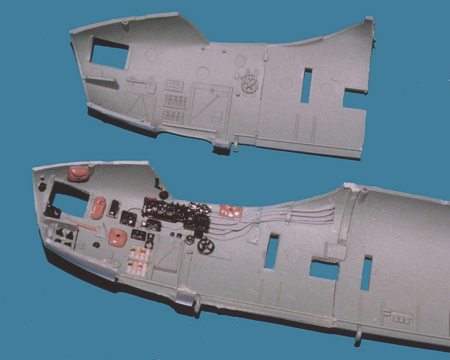 |
Once I had painted the interior of both cockpit halves it was necessary to cut the kit fuselage was cut immediately in front of the dinghy storage hatch, on the top of the aircraft, and extend the line vertically down the side. The relevant resin part was then mated to the plastic using super glue, checking for fit. Once it had dried the join was sanded back and the two fuselage halves were dry test-fitted. Everything looked OK so I continued onto the next stage of assembling the pilot and navigator office.
The instrument panel was given a coat of Tamiya X-18, semi-gloss black and prior to mating the front and rear portions of the panels the rear of the front panel was sanded to allow the instrument "holes" to appear. This allows the modeller to use the acetate sheet supplied – oops, mine had disappeared! I used the next best thing, the decal sheet from the kit. This is where I found that the kit supplies an instrument panel decal for the bomber only. Judicious cutting and repositioning of the instrument dials had the problem fixed.
 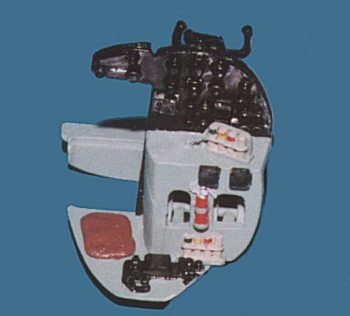 |
The radio equipment was painted semi-gloss black and the dials were painted white. I have been fortunate enough to climb inside a Lancaster on display at the Perth Air Museum, Bull Creek in Western Australia and see first hand the radio receiver used. From my photos of the internals of the "Lanc" I painted the radio for the Mosquito. I did have some trouble getting the "Gee" box to fit at 30 degrees behind the pilot’s seat, some trusty superglue and onto the next step!
 The final hurdle in
attaching the resin cockpit bits came when I did the test fit of the
"Z-floor" to the kit bomb bay. Kit part A13 is attached to part J14
that requires two holes to be drilled to allow the cameras to be attached. The
resin parts correspond with J14 and the forward portion of A13. These must be
removed to allow the whole assembly to fit into the fuselage. This was omitted
from the Cutting Edge instructions and requires some measuring to assess where
to do the appropriate surgery. Holes were then drilled into the resin
"Z-floor", taking care not to drill through the navigator’s seat –
ouch!
The final hurdle in
attaching the resin cockpit bits came when I did the test fit of the
"Z-floor" to the kit bomb bay. Kit part A13 is attached to part J14
that requires two holes to be drilled to allow the cameras to be attached. The
resin parts correspond with J14 and the forward portion of A13. These must be
removed to allow the whole assembly to fit into the fuselage. This was omitted
from the Cutting Edge instructions and requires some measuring to assess where
to do the appropriate surgery. Holes were then drilled into the resin
"Z-floor", taking care not to drill through the navigator’s seat –
ouch!
The bomb bay received special attention as per the references and each fuel cell was painted with the suggested Tamiya XF-7 and XF-9, Flat Red and Hull Red in the ratio of 5:1. The cameras were installed and a blob of Humbrol Clear Fix was used to simulate each lens. This was also done for the rear camera that sits behind the bomb bay. The bomb bay door actuating levers and the bomb bay racks were attached, although no bombs are used in this variant. The rear bulkhead was attached to the bomb bay and special spar used to locate the wings was also attached. This required a 1" by 1/8" section to be removed to allow for clearance from the cockpit floor. Just a word of caution when installing the rear camera cover, on my model it was a very tight fit and over-zealous pressing split the clear plastic.
The whole assembly was then attached to the port fuselage half and the two parts cemented using superglue to speed the bonding time. I used some handy plastic clamps to hold the whole lot together until it set.
The electrical wires and pipes that extend down both sides of the bomb bay were to be installed as one of the final steps, along with the canopy and other clear parts.
The Fuselage and Wings
The fuselage halves were glued in place ensuring that the cockpit and bomb bay areas were not obstructing the join. The rear tail wheel was also glued into position, although it was not necessary as it can be done at a later stage. I did have some problems with the dry fitting of the resin cockpit and had removed some of the nose section on the joins prior to joining the halves.
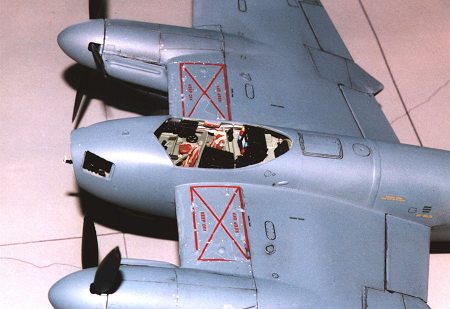 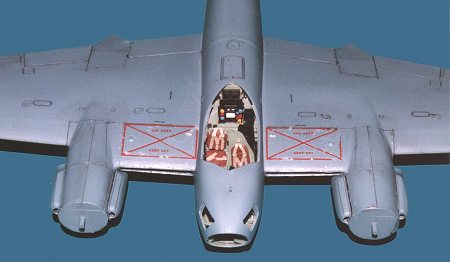 |
Once the fuselage halves were dry I then proceeded to attach both the main wings and tailplanes. It is important to observe the instructions at this point as where the main wings connect onto the spars of the bomb bay sub assembly, a pin is used to provide a solid connection. I should have realized that something was amiss at this point, as the spars did not seem to extend far enough into the wing to allow the alignment of the holes in both parts of the wing and bomb bay sub assembly. I simply cut off the pin from the connector and glued it into place.
The wings are presented in two halves per side and it is necessary to attach the landing lights into the lower surface prior to joining the upper and lower portions. I used Bare Metal Foil on the inside of the light to simulate the reflector and attached one per wing. The engine nacelles were left off at this stage as extra work was to be done on both. The airframe plus wings was then set aside to dry. I used a small amount of filler at the wing root join, mainly due to a slight mismatch between the resin and plastic – more of an oversight on the part of this modeller than a fault of Mr. Tamiya or indeed, Mr. Cutting Edge.
Undercarriage
 The
undercarriage gets a little bit of extra treatment with the addition of cables
and brake lines down the outside of both undercarriage struts on the main
wheels. I used the plastic sheath of some very thin wire to simulate the rubber
runners for the cables attached to the folding mechanism, at the rear of each
leg and then ran a wire across each runner. A small piece of plastic pipe was
attached to the base of the oil tank and connected to the front struts, with
additional piping disappearing into the tank.
The
undercarriage gets a little bit of extra treatment with the addition of cables
and brake lines down the outside of both undercarriage struts on the main
wheels. I used the plastic sheath of some very thin wire to simulate the rubber
runners for the cables attached to the folding mechanism, at the rear of each
leg and then ran a wire across each runner. A small piece of plastic pipe was
attached to the base of the oil tank and connected to the front struts, with
additional piping disappearing into the tank.
The wheel well bays were also given some treatment in the form of two springs per well. These springs were connected to the rear of the doors and acted as an additional closing force. To complete this assembly a piece of plastic card was shaped to the rear of the wheel well and drilled and attached to the rear bulkhead. The springs were attached to the top of the wheel well and, from the base of the springs, two wires run down to the edges of the undercarriage doors.
The tyres were painted Gunze Sangyo, Tire Black and were then dry brushed with some grey across the tread to simulate wear as a result of rolling across concrete surfaces.
|
PAINT & DECALS |
The Spray Painting Phase
Following the advice of previous modellers I decided to cover the engine nacelles and inboard areas of the engines with Bare Metal Foil, Matt Aluminium. This area was prone to wear and tear from the erks as well as the elements. I struggled with getting the foil to sit across the complex surfaces and eventually hit upon the idea of using the end of a toothpick to gently rub the foil. The toothpick end was suitably rounded and the final effect was to show every tiny bit of detail even allowing me to press it into some of the fine rivet detail around the engine covers. I also elected to use a thin piece of foil along the spine of the airframe, both top and bottom, to simulate the tape used on the real thing. Although it hides the seam I remain unconvinced that it was a good move as the foil is visible against the fuselage and could have been slightly narrower. Future builds of this kit will see me keeping it to a very narrow strip.
Once this had been completed I masked off the wheel wells, bomb bay and clear parts with Tamiya masking tape and tissues, moistened to fit snugly into the recesses of the airframe. The model was finally ready for the spraying.
This is probably one of the easiest colour schemes to paint. Open one bottle of Model Masters, PRU Blue, thin with preferred thinners (Tamiya Enamel Thinners in this case) and spray to your heart’s content, the wheel well doors, propellers and entry doors being sprayed independently.
The Canopy
 Obsessive?
Me? Tamiya have produced a very clear canopy with raised detail for the external
panels and internal detail, plus decals, to show the extent of internal canopy
framing. Sounds good? I, however, had other ideas. Maybe the colour of the
decals wasn’t quite what I expected or maybe my brain had become frazzled
during the cockpit phase and this all combined to see me cutting pieces of
copper wire to run along the insides of the canopy. Worse, each piece was
lovingly painted prior to being attached to the inside of the canopy, with
enough allowance to look as if it was connected to the airframe. I agonized over
how to cut and shape each successive part of the framing, but once started there
was no going back. The final result looks great and I would do it again just for
the look. Shame about the lack of photo, but as it was a first attempt the
second will be better. I did not go to the trouble of adding other bits and
pieces such as the Very pistol and internal light, maybe another time.
Obsessive?
Me? Tamiya have produced a very clear canopy with raised detail for the external
panels and internal detail, plus decals, to show the extent of internal canopy
framing. Sounds good? I, however, had other ideas. Maybe the colour of the
decals wasn’t quite what I expected or maybe my brain had become frazzled
during the cockpit phase and this all combined to see me cutting pieces of
copper wire to run along the insides of the canopy. Worse, each piece was
lovingly painted prior to being attached to the inside of the canopy, with
enough allowance to look as if it was connected to the airframe. I agonized over
how to cut and shape each successive part of the framing, but once started there
was no going back. The final result looks great and I would do it again just for
the look. Shame about the lack of photo, but as it was a first attempt the
second will be better. I did not go to the trouble of adding other bits and
pieces such as the Very pistol and internal light, maybe another time.
All that remained was to attach the masterpiece to the airframe. It was now that the disaster, alluded to earlier, became apparent. Having gone through successive dry test fitting of the cockpit internal halves it simply did not occur to me that the cockpit might be too wide. Oops! The canopy did not fit to the edge of the airframe and resulted in air bluer than the fuselage emanating from this builder!
The best I could do was to stretch the rear of the canopy, very carefully, and glue the whole assembly before the clear plastic reverted to its original shape. I also used a small amount of glue to build up the sides of the airframe to disguise the mismatch. Close inspection sees the problem, although it was easier to do this than sand down the fuselage to match the canopy. I am not sure if Cutting Edge is aware of the problem or if it is something I should have checked and therefore corrected before this stage. Oh well, I’ll know better next time!
The Decals
The decals supplied are from the kit and are those used to depict an aircraft from No. 540 Squadron. They are thin and with a small amount of solvent sat with little or no silvering.
Normally the almost finished aircraft is given a coat of gloss prior to attaching the decals to prevent silvering. For this model I decided to rub the paint surface to obtain a sheen that would avoid the spraying. Using a small cloth, the areas to receive decals were polished to give a nice shine and the decal attached. The only area where I feel that the effort was not totally successful was the inboard engine nacelle area. The decal that goes here has a large carrier film surface and it may have been prudent to cut the clear parts prior to fitting. I elected not to go that way as the area was going to receive some weathering in the form of paint chipping and the decals were also going to suffer.
 All that
now remained was to attach the fiddly bits such as the aerial mast, aerials,
bomb bay doors, and cockpit access doors and weather the panel lines.
All that
now remained was to attach the fiddly bits such as the aerial mast, aerials,
bomb bay doors, and cockpit access doors and weather the panel lines.
I have always seemed to encounter problems with this technique and have oscillated between pre-shading and attempting to paint the lines, albeit with a very fine brush. This time I have been lucky enough to be shown how it is done. I used watercolours in an artist’s palette. The trick: add a small amount of paint, about 5mm (1/4 inch) to the palette, add a very small amount of detergent, perhaps one drop, directly to the paint and mix. Sparingly add water until it is a smooth and of a fluid consistency. Dip a fine paintbrush into the mixture and apply to the surface of the model. The best surface to work with here is a matte or semi gloss finish. The paint will flow along the panel line. The detergent helps reduce the surface friction allowing the paint to flow. Tipping the model sometimes helps, although the lines act as a capillary for the mixture. If it goes outside the panel lines it doesn’t matter, it can be simply removed when it has dried with a slightly moist tissue.
The beauty of using watercolours is simply that. They are water based and easily removed from an acrylic or enamel paint surface without damage to either. If too much is used, simply remove the paint and start again. When you are finished don’t wash out the palette, add water to the bowls and use again for the next project.
Once the paint has dried in the lines the excess can be
brushed away, in the direction of airflow to simulate slipstream effects, or
simply dab the spillage with a moistened tissue to leave a crisp line behind. I
use a thick bristle brush that has been moistened, not saturated, and brush
across the panel line to pick up some of the paint and spread it back over the
surface. If too much is removed simply paint it back on and repeat the process
until the desired effect is achieved.
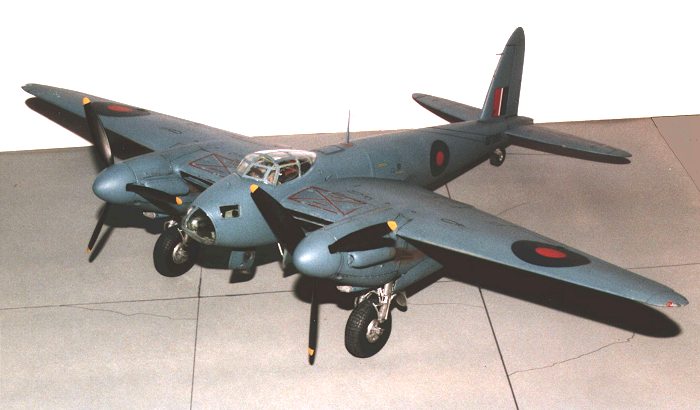
|
CONCLUSIONS |
I have been fortunate to have had access to some fantastic material and used this to build my model. Some of the best books around were used and, because this kit had been anticipated for so long it was also the subject of a number of photo builds in various modeling magazines (see the References). Thus armed I have been able to build a highly detailed kit and to those modellers who have presented their Mosquito reviews elsewhere, my thanks.
|
REFERENCES |
De Havilland Mosquito Aero Detail No.23, Publisher Dai Nippon Kaiga Co., Ltd., 1999 ISBN: 4-499-22695-3
Mosquito Bomber/Fighter Bomber Units 1942-45 Bowman, M., Osprey Combat Aircraft No. 4, Osprey Publishing Ltd.,1997, Reprinted 1998, ISBN: 1-85532-690-6
Mosquito Fighter/Fighter-Bomber Units of World War 2 Bowman, M., Osprey Combat Aircraft No. 9, Osprey Publishing Ltd.,1998, ISBN: 1-85532-731-7
Walk Around Mosquito MacKay, R., Squadron/Signal Publications, Walk Around No. 15, 1998 ISBN: 0-89747-396-5
Mosquito in Action Part 2 Scutts, J., Squadron/Signal Publications, Aircraft No. 139, 1993 ISBN: 0-89747-303-5
True Blue Photo Reconnaissance Mosquito Coughlin, G., Aircraft Kit Review De Havilland Mosquito B Mk.IV/PR MK.IV, Tamiya Model Magazine #79, April/May 2000, ADH Publishing
Photo Build – de Havilland Mosquito B Mk IV Franks, R.A., Scale Aviation Modeller International, SAM Publications, Volume 6 Issue 2, February 2000
If you would like your product reviewed fairly and quickly by a site that has over 1,000 visits a day, please contact me or see other details in the Note to Contributors.